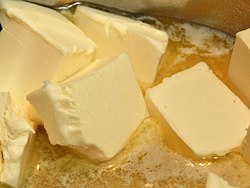Composition

Butterfat is mainly composed of triglycerides. Each triglyceride contains three fatty acids. Butterfat triglycerides contain the following amounts of fatty acids (by mass fraction): [1] [2] [3]
Butterfat contains about 3% trans fat, which is slightly less than 0.5 grams per US tablespoon. [3] Trans fats occur naturally in meat and milk from ruminants. The predominant kind of trans fat found in milk is vaccenic fatty acid. Trans fats may be also found in some industrially produced foods, such as shortenings obtained by hydrogenation of vegetable oils. In light of recognized scientific evidence, nutritional authorities consider all trans fats equally harmful for health and recommend that their consumption be reduced to trace amounts. [4] [5] [6] [7] [8] However, two Canadian studies have shown that vaccenic acid could be beneficial compared to vegetable shortenings containing trans fats, or a mixture of pork lard and soy fat, by lowering total LDL and triglyceride levels. [9] [10] [11] [12] [13] A study by the US Department of Agriculture showed that vaccenic acid raises both HDL and LDL cholesterol, whereas industrial trans fats only raise LDL with no beneficial effect on HDL. [14]
| Fatty acid | length | mol% (rounded) | 1 | 2 | 3 |
|---|---|---|---|---|---|
| Butyryl | C4 | 12 | 0 | 0 | 100 |
| Caproyl | C6 | 5 | 0 | 7 | 93 |
| Caprylyl | C8 | 2 | 25 | 12 | 63 |
| Capryl | C10 | 4 | 17 | 27 | 56 |
| Lauryl | C12 | 4 | 42 | 53 | 5 |
| Myristyl | C14 | 11 | 29 | 52 | 19 |
| Palmityl | C16 | 24 | 47 | 45 | 8 |
| Hexadecenoyl | C16:1 | 3 | 36 | 46 | 18 |
| Stearyl | C18 | 7 | 49 | 45 | 6 |
| Oleyl | C18:1 | 24 | 42 | 26 | 32 |
| Linoleyl | C18:2 | 3 | 23 | 47 | 31 |
